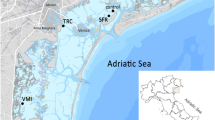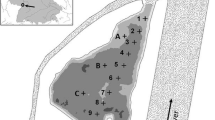Abstract
Toxicity assessment based on sediment chronic bioassays with the aquatic worm Tubifex tubifex was performed at ten contaminated sites in the industrial area of Bilbao (Northern Spain). One control and three reference sites were also included. Tubifex bioassay measures both survival and reproduction impairment. These endpoints have been contrasted and discussed in relation to somatic growth and both individual and total biomass of cocoons. Survival was only affected at one site which was heavily contaminated by organic compounds, mainly PAHs. A group of four severely ecotoxic sediments was characterised by a drastic reduction in number and size of cocoons, and adult somatic growth. In other group of sediments, some significant increases were found for these variables. It is suggested that these increases represent an effect of hormesis. An index of reproductive effort was used to integrate the relationship between somatic growth and reproduction. Values of reproductive effort at the test sediments were lower than those at the control sediment, suggesting a conservative strategy of oligochaete worms which consisted in an investment into somatic line (growth) at the expenses of offspring. Rates of food consumption which were estimated from egestion rates, were low at the contaminated sites. This fact could be related to the low production levels found at these sites and may reflect avoidance feeding behaviour of the oligochaete worms within the sediments. At some reference sites, high production could have resulted from high nutritional quality of sediments, or to an hormetic effect due to low concentration of some chemicals. Results are discussed in relation to toxicity data from sediment three-brood bioassay with Daphnia magna Straus performed separately on the same sediments.
Similar content being viewed by others
References
Alba-Tercedor, J. and Sanchez-Ortega, A. (1988). Un método rápido y simple para evaluar la calidad biológica de las aguas corrientes basado en el de Hellawell (1978). Limnetica 4, 51–56.
Armitage, P.D., Moss, D., Wright, J.F. and Furse, M.T. (1983). The performance of a new biological water score system based on macroinvertebrates over a wide range of unpolluted running water sites. Water Research 17, 333–347.
ASTM E 1383–94. (1994). Standard Guide for Conducting Sediment Toxicity Tests with Freshwater Invertebrates, pp. 18–20. Philadelphia, ASTM.
Back, H. (1990). Epidermal uptake of Pb, Cd, and Zn in tubificid worms. Oecologia 85, 226–232.
Basque Government (1995). Red de Vigilancia de la calidad de las aguas y del estado ambiental de los ríos de la CAPV. 177 pp. Gobierno Vasco, Vitoria: Servicio Central de Publicaciones.
Berg, K., Jonasson, P.M. and Ockelmann, K.W. (1962). The respiration of same animals from the profundal zone of a lake. Hydrobiologia 19, 1–39.
Brandt, E. von. (1978). Adaptations of Tubifex tubifex Müller (Annelida, Oligochaeta) to temperature, oxygen tension and nutritional conditions. Archiv. F. Hydrobiologie 84(3), 302–338.
Brinkhurst, R.O. and Austin, M.J. (1979). Assimilation by aquatic oligochaeta. Inter. Rev. ges. Hydrobiol. 64(2), 245–250.
Casellato, S. and Negrisolo, P. (1989). Acute and chronic effects of an anionic surfactant on some freshwater tubificid species. Hydrobiologia 180, 243–252.
Chapman, P. (1987). Oligochaete respiration as a measure of sediment toxicity in Puget Sound, Washington. Hydrobiologia 155, 249–258.
Chapman, P. and Brinkhurst, R.O. (1984). Lethal and sublethal tolerances of aquatic oligochaetes with reference to their use as biotic index of pollution. Hydrobiologia 115, 139–144.
Chapman, P., Farrel, M.A. and Brinkhurst, R.O. (1982). Relative tolerances of selected aquatic oligochaetes to individual pollutants and environmental factors. Aquatic Toxicology 2, 47–67.
Chapman P.M., Power, E.A. and Burton Jr., G.A. (1992). Integrative assessments in aquatic ecosystems. In G. A. Burton (ed.) Sediment Toxicity Assessment pp. 313–340. Boca Raton: Lewis Publishers.
Giesy, J.P. and Hoke, R.A. (1990). Freshwater sediment quality criteria: Toxicity bioassessment. In R. Baudo, J.P. Giesy and H. Muntau (eds.) Sediments: Chemistry and Toxicity of In-Place Pollutants, pp. 265–348. Boston: Lewis Publishers.
Keilty, T.J. and Landrum P.F. (1990). Population-specific toxicity responses by the freshwater oligochaete, Stylodrilus heringianus, in natural Lake Michigan sediments. Environmental Toxicology Chemistry 9, 1147–1154.
Laughlin, R.B., Jr., Ng, J. and Guard, N.E. (1981). Hormesis: a response to low environmental concentrations of petroleum hydrocarbons. Science 211, 705–707.
Martinez-Madrid, M., Rodriguez, P. and Perez-Iglesias, J.I. Sediment toxicity bioassays for assessment of contaminated sites in the Nervion river (Northern Spain). 1. Three-brood sediment chronic bioassay of Daphnia magna Straus. Ecotoxicology 8(2), 97–109.
Milbrink, G. (1987). Biological characterisation of sediments by standardised tubificid bioassays. Hydrobiologia 155, 267–275.
Moore, D.W. and Dillon, T.M. (1993). The relationship between growth and reproduction in the marine polychaete Nereis (Neanthes) arenaceodentata (Moore): implications for chronic sublethal sediment bioassays. Journal of Experimental Marine Biology & Ecology 173, 231–246.
Poddubnaya, T.L. (1980). Life cycles of mass species of Tubificidae (Oligochaeta). In R.O. Brinkhurst and D.G. Cook (eds.) Aquatic Oligochaete Biology, pp. 175–184. New York: Plenum Press.
Reynoldson, T. (1994). A field test of a sediment bioassay with the oligochaete worm Tubifex tubifex (Müller, 1774). Hydrobiologia 278, 223–230.
Reynoldson, T.B., S.P. Thompson and Bampsey, J.L. (1991). A sediment bioassay using the tubificid oligochaete worm Tubifex tubifex. Environmental Toxicology and Chemistry, 10, 1061–1072.
Reynoldson, T.B., Bailey, R.C., Day, K.E. and Norris, R.H. (1995). Biological guidelines for freshwater sediment based on Benthic Assessment of Sediment (The Beast) using a multivariate approach for predicting biological state. Australian Journal of Ecology 20, 198–219.
Reynoldson, T.B., Day, K.E., Clarke, C. and Milani, D. (1994). The effects of indigenous animals on chronic endpoints in freshwater sediment toxicity tests. Environmental Toxicology and Chemistry 13, 973–977.
Reynoldson, T.B., Rodriguez, P. and Martinez, M. (1996). A comparison of reproduction, growth and acute toxicity in two populations of Tubifex tubifex (Müller, 1774) from the North American Great Lakes and Northern Spain. Hydrobiologia 334, 199–206.
Rodriguez, P. (1984). Los Oligoquetos acuáticos del Río Nervion (Vizcaya España): Resultados faunísticos generales. Limnetica 1, 169–178.
Rodriguez, P. and Wright, J.F. (1991). Description of a sampling strategy for macroinvertebrate communities in Basque rivers (Spain). Hydrobiologia 213, 113–124.
Stearns, S.C. (1992). The Evolution of Life Histories. New York: Oxford University Press.
Wiederholm, T. and Dave, G. (1989). Toxicity of metal polluted sediments to Daphnia magna and Tubifex tubifex. Hydrobiologia 176/177, 411–417.
Wiederholm, T., Wiederholm, A.M. and Milbrink, G. (1987). Bulk sediment bioassay with five species of fresh-water oligochaetes. Water, Air and Soil Pollution 36, 131–154.
Author information
Authors and Affiliations
Corresponding author
Rights and permissions
About this article
Cite this article
Martinez-Madrid, M., Rodriguez, P., Perez-Iglesias, J.I. et al. Sediment Toxicity Bioassays for Assessment of Contaminated Sites in the Nervion River (Northern Spain). 2. Tubifex tubifex Reproduction Sediment Bioassay. Ecotoxicology 8, 111–124 (1999). https://doi.org/10.1023/A:1008966702822
Issue Date:
DOI: https://doi.org/10.1023/A:1008966702822




